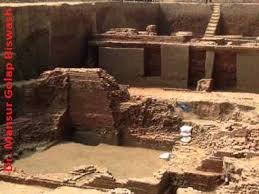Wari-Bateshwar: A Historical and Archaeological Overview
History:
Wari-Bateshwar, located in the Narsingdi district of Bangladesh, is one of the most significant archaeological sites in South Asia, with a history that stretches back to around 450 BCE. The site is believed to be part of an ancient urban center that had extensive trade links with regions as far away as Rome, Southeast Asia, and China. The area’s historical significance is highlighted by the discovery of numerous artifacts that suggest it was a flourishing economic hub during the early historic period.
Geography:
Wari-Bateshwar is situated on the eastern bank of the Old Brahmaputra River. The geography of the area includes fertile plains, which were advantageous for agriculture, contributing to the sustenance of a large population. The proximity to the Brahmaputra River facilitated trade and communication, making Wari-Bateshwar a strategic location for commerce and cultural exchange.

Discover an ancient city
Discovery:
The potential significance of Wari-Bateshwar was first noted in the early 20th century when local residents found ancient coins and other artifacts. However, it wasn’t until the 1930s that Badruddin Ahmed, a local school teacher, and later his son Habibullah Pathan, brought the site’s importance to the attention of scholars. Systematic archaeological research began much later, in the 1970s, led by Dr. M. Habibullah Pathan and others from Jahangirnagar University, who conducted extensive surveys and excavations that unearthed a wealth of historical data.
Excavation:
Archaeological excavations at Wari-Bateshwar have revealed numerous artifacts, including silver punch-marked coins, Northern Black Polished Ware (NBPW), iron implements, and semi-precious stone beads. The findings indicate the existence of a well-planned city with fortifications, roads, and possibly an administrative center. The discovery of a rampart, indicative of a city wall, suggests that the settlement was of considerable importance and required protection.

They dig a spot.
Culture:
The cultural artifacts found at Wari-Bateshwar reflect a sophisticated and cosmopolitan society engaged in various economic activities, including agriculture, trade, and crafts. The presence of NBPW points to cultural and trade links with the Mauryan Empire, while the variety of beads and coins indicates extensive trade networks. The evidence of iron smelting and metalworking suggests advanced technological capabilities.
The societal structure inferred from the artifacts suggests that Wari-Bateshwar was an affluent urban center with a complex social hierarchy. The variety of objects, from utilitarian goods to luxury items, points to a diverse and vibrant community with a rich cultural life.

Valuable stone collect from this spot.
Wari-Bateshwar stands as a testament to the rich historical and cultural heritage of Bangladesh. The site provides invaluable insights into early urbanization in the region, the economic and technological prowess of its inhabitants, and their extensive trade networks. Continued archaeological research promises to uncover even more about this ancient city’s past, offering a deeper understanding of its role in South Asian history.o.
How to Travel from Dhaka to Wari-Bateshwar
Location: Wari-Bateshwar is located in the Belabo Upazila of Narsingdi district, approximately 70 kilometers northeast of Dhaka, the capital of Bangladesh.
Travel Options:
By Road:
- Car/Taxi: The most convenient way to reach Wari-Bateshwar from Dhaka is by car or taxi. The journey typically takes around 2-3 hours, depending on traffic conditions. You can take the Dhaka-Sylhet Highway (N2) and then follow local roads to reach Belabo Upazila.
- Bus: Several buses operate from Dhaka to Narsingdi. From the bus terminals like Mohakhali or Sayedabad, you can board a bus heading towards Narsingdi. Upon reaching Narsingdi, you may need to hire a local transport such as a CNG (three-wheeler) or an auto-rickshaw to reach Wari-Bateshwar.
By Train:
- Train: You can take a train from Dhaka’s Kamalapur Railway Station to Narsingdi Railway Station. From Narsingdi, local transport options like CNG or auto-rickshaw are available to take you to Wari-Bateshwar.

Area of Wari-Bateshwar
The archaeological site of Wari-Bateshwar covers an extensive area, estimated to be around 10 square kilometers. This area includes multiple mounds, indicative of ancient urban settlements, fortifications, and possible administrative and residential zones. The actual archaeological excavations cover smaller, specific parts of this larger area, where significant findings have been concentrated.













